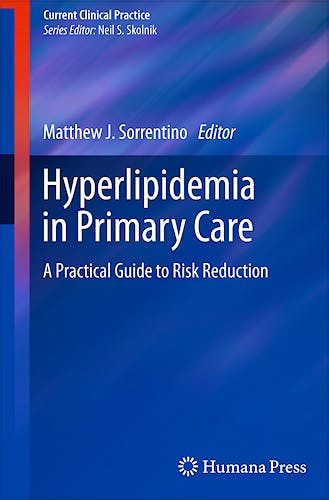

No hay productos en el carrito



Hyperlipidemia in Primary Care. a Practical Guide to Risk Reduction (Current Clinical Practice)
Sorrentino, M.
1ª Edición Septiembre 2011
Inglés
Tapa blanda
300 pags
1000 gr
16 x 24 x 1 cm
ISBN 9781603275019
Editorial HUMANA PRESS
LIBRO IMPRESO
-5%
103,99 €98,79 €IVA incluido
99,99 €94,99 €IVA no incluido
Recíbelo en un plazo de
2 - 3 semanas
Primary care physicians and allied providers need to have a thorough understanding of the evaluation of cardiac risk and the treatment of dyslipidemias. Cholesterol is the primary target of treatment for cardiovascular risk reduction. Primary care providers must first be able to calculate cardiac risk to categorize patients into individual risk treatment groups. A large number of clinical trials and treatment guidelines and recommendations have been published since the last National Cholesterol Education Program (NCEP) Adult Treatment Panel recommendations were disseminated five years ago. This book will present an updated view of this confusing literature and recommendations and focus on an easy and practical way to approach cardiac risk reduction.
A major portion of the book will present a risk reduction approach to common, difficult patient types with practical recommendations. The book will begin with a discussion of cardiovascular risk evaluation that will go beyond the NCEP risk calculator. It will incorporate decision making revolving around the metabolic syndrome, biomarkers such as inflammatory markers, and the role of non-invasive atherosclerotic imaging (Calcium score, CT angiography, carotid IMT). The second section will give an overview of lipoprotein metabolism and the development of atherosclerosis. We can then discuss the role of advanced lipid testing and the inherited lipid disorders. Section three will give an overview of treatment starting with lifestyle modification and then will cover pharmacological therapy. The fourth and most important section will present specific patient examples and a very practical approach to treatment. The patient types will be common patients that the Primary Care Physician would see and difficult problems that do not easily fit the current guidelines.
The following is an outline of the chapters for the book. There are 16 chapters with each projected to be 15 - 20 pages.
Written for: Family practitioners, internal medicine physicians, nurse practitioners, physician assistants
Table of contents
1. Cardiovascular Risk Evaluation
1. Risk Factor Assessment – how to calculate CVD risk, use of Framigham
and ATPIII risk calculator, discussion of novel risk factors including inflammatory
markers and how they would modify risk
2. Metabolic Syndrome – overview of metabolic syndrome, diagnosis, impact
of risk of diabetes and CVD
3. Non-invasive Imaging – discussion of CT, CIMT and other non-invasive
imaging, role in risk evaluation
2. Lipoproteins and Atherosclerosis
1. Lipoprotein metabolism
2. Development of Atherosclerosis
3. Inherited Lipoprotein Disorders
4. Advanced Lipid Testing - III Treatment of Dyslipidemias
5. Therapeutic Lifestyle Changes
6. Drug Therapy for Dyslipidemia - IV Special Populations – Practical
Approach to Therapy
7. Familial Hyperlipidemia (High LDL) – also discussion of treatment guidelines
for children and adolescents
8. Severe Hypertriglyceridemia
9. Metabolic Syndrome/Diabetes mellitus (mixed hyperlipidemia)
10. Isolated Low HDL
11. High Lipoprotein(a)
12. End Stage Renal Disease
13. HIV with dyslipidemia
© 2026 Axón Librería S.L.
2.149.0